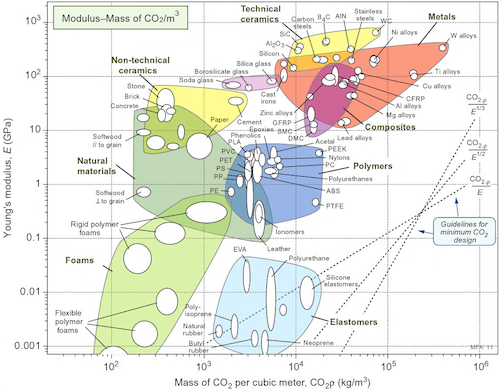Embodied carbon footprint is the amount of carbon (CO2) emission to produce a material.
Except for biodegradable plastics, plastics are made from so‐called feedstocks derived from crude oil refining and natural gas processing. About half the fossil fuel goes into the plastic itself while the remaining half is combusted to provide the energy during manufacture, meaning it takes about 2 kg of fossil fuel to produce 1kg of plastics. Petroleum holds in average 43 MJ/kg, plastic production requires about 86 MJ/kg. With about 3 hydrogen atoms for every carbon atom (15 g/mol) in the fuel consumed, the CO2 (44 g/mol) emission is 44/15 = 2.9 kg of CO2 for every kg of plastics produced. Because different production paths consume different amounts of energy, the energy used in the production of a chemical depends on its feedstock. Chemical obtained from the cracking and distillation of petroleum or inorganic sources are called raw materials. The total energy consumed in the production is the sum of the energy inputs for itself and all its predecessors, starting from the raw material. Energy is not only spent and CO2 released in producing the material but also in shaping it into its desired form. Primary shaping processes are e.g. casting, rolling, extrusion, molding etc. Secondary processes are e.g. welding, heat-curing, painting, coating, etc. The listed values are supposed to contain the energy and CO2 for material and processes for cable production.
Sources:
Note:
| Id | kgCO2/kg | kgCO2e/kg | Comment |
|---|---|---|---|
| PVC | 2.61 | 3.1 | (1) general type |
| PE | 2.04 | 2.54 | (1) general type |
| sPVC | 2.61 | 3.1 | ≈PVC |
| sPE | 2.04 | 2.54 | ≈PE |
| LDPE | 1.69 | 2.08 | (1) |
| MDPE | 1.69 | ≈LDPE (no reference found) | |
| HDPE | 1.57 | 1.93 | (1) |
| XLPE | 1.57 | ≈HDPE (no reference found) | |
| XLPEf | 1.57 | ≈XLPE | |
| PP | 3.69 | (2) production 83/3.2 plus extrusion 6.5/0.49 | |
| PPLP | 4.11 | 50/50% paper/PP, paper 50% soaked oil/rosin | |
| PUR | 4.06 | 4.84 | (1) flexible foam |
| PS | 4.48 | 4.39 | (2) production 102/4.0 plus extrusion 6.4/0.48 |
| PA | 8.79 | 7.92 | (2) production 129/8.3 plus extrusion 6.5/0.49 |
| STPe | 2.04 | ≈PE (no reference found) | |
| POC | 2.04 | ≈PE (no reference found) | |
| ETFE | 10.08 | 80% of max value or range 26.5-210, CO2 acc. rule of thumb | |
| PET | 2.35 | (2) production 89/4.1 plus extrusion 6.4/0.48 | |
| PTFE | 7.0 | approx. value from figure | |
| HFFR | 2.04 | no reference found, ≈PE | |
| FRNC | 2.04 | no reference found, ≈PE | |
| NR | 3.6 | (2) production 71/2.2 plus moulding 17/1.4 | |
| EPR | 8.3 | ≈IIR (no reference found) | |
| EPDM | 8.3 | ≈EPR | |
| EVA | 2.68 | (2) production 83/2.2 plus extrusion 6.0/0.48 | |
| XHF | 1.7 | ≈PE | |
| HFS | 1.7 | ≈PE | |
| CR | 2.2 | (2) production 68.0/1.7 plus moulding 18.5/1.5 | |
| CSM | 2.04 | ≈PE (no reference found) | |
| IIR | 8.3 | (2) production 124/6.9 plus moulding 16/1.4 | |
| PIB | 3.6 | ≈NR (no reference found) | |
| OilP | 3.04 | paper 50% soaked mineral oil (49.9/3.09) | |
| Mass | 3.04 | paper 50% soaked oil/rosin (≈mineral oil) | |
| CJ | 3.91 | 60% jute + 40% PP | |
| RSP | 3.6 | ≈NR | |
| BIT | 0.43 | 0.55 | (1) bitumen |
| tape | 1.49 | ≈paper | |
| SiR | 14.1 | (1) silicon, CO2 acc. rule of thumb | |
| fPOC | 2.04 | ≈POC | |
| fPP | 3.93 | 4.49 | ≈PP |
| fPVC | 2.61 | 3.1 | ≈PVC |
| fPE | 2.04 | 2.54 | ≈PE |
| PRod | 2.61 | ≈PVC (no reference found) | |
| PTube | 2.61 | ≈PVC (no reference found) | |
| OilD | 3.04 | assuming similar to oil impregnated paper | |
| Jute | 4.05 | (4) ≈hemp | |
| TY | 3.5 | (2;3) ≈wool | |
| Paper | 1.49 | (1) excluding calorific value of wood | |
| Air | 0.0 | ||
| Cu | 2.6 | 2.71 | (1) EU tube & sheet type |
| Al | 8.24 | 9.16 | (1) general type |
| AL3 | 8.24 | 9.16 | |
| ENAW6060 | 8.24 | 9.16 | |
| Pb | 1.57 | 1.67 | (1) general type |
| Brz | 3.73 | 4.0 | (1) |
| CuSn | 3.73 | 4.0 | ≈Brz |
| CuZn | 2.46 | 2.64 | (1) |
| Fe | 1.91 | 2.03 | (1) |
| S | 1.37 | 1.46 | (1) general type, 59% recycled content |
| SS | 6.15 | (1) | |
| Zn | 2.88 | 3.09 | (1) general type |
| Ni | 11.5 |

Materials Engineering Science Processing and Design, Figure 2.10 - M. Ashby et al. (2007)